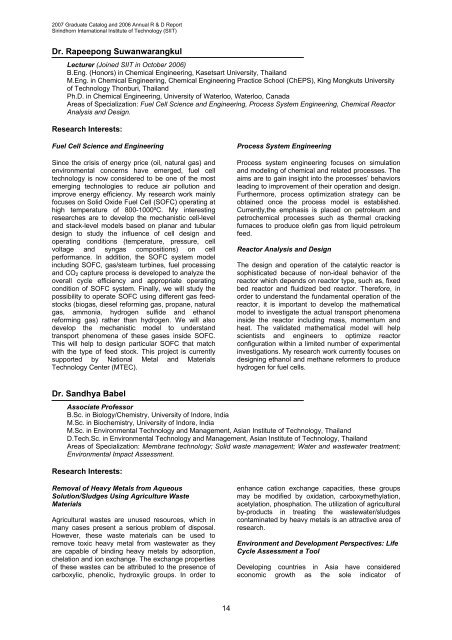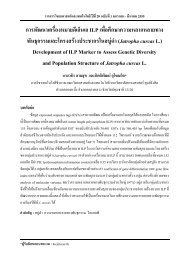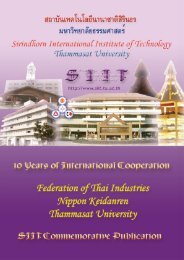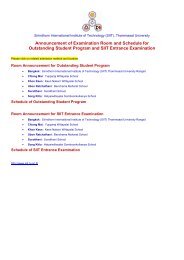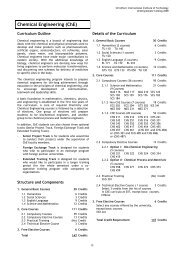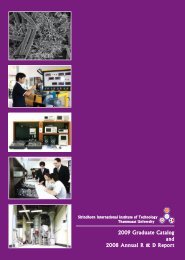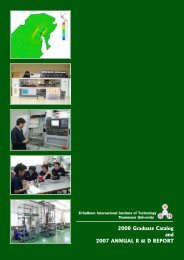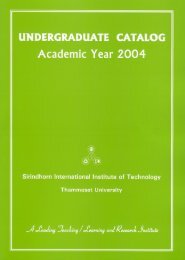2007 Graduate Catalog and 2006 Annual R & D Report - Sirindhorn ...
2007 Graduate Catalog and 2006 Annual R & D Report - Sirindhorn ...
2007 Graduate Catalog and 2006 Annual R & D Report - Sirindhorn ...
You also want an ePaper? Increase the reach of your titles
YUMPU automatically turns print PDFs into web optimized ePapers that Google loves.
<strong>2007</strong> <strong>Graduate</strong> <strong>Catalog</strong> <strong>and</strong> <strong>2006</strong> <strong>Annual</strong> R & D <strong>Report</strong><br />
<strong>Sirindhorn</strong> International Institute of Technology (SIIT)<br />
Dr. Rapeepong Suwanwarangkul<br />
Lecturer (Joined SIIT in October <strong>2006</strong>)<br />
B.Eng. (Honors) in Chemical Engineering, Kasetsart University, Thail<strong>and</strong><br />
M.Eng. in Chemical Engineering, Chemical Engineering Practice School (ChEPS), King Mongkuts University<br />
of Technology Thonburi, Thail<strong>and</strong><br />
Ph.D. in Chemical Engineering, University of Waterloo, Waterloo, Canada<br />
Areas of Specialization: Fuel Cell Science <strong>and</strong> Engineering, Process System Engineering, Chemical Reactor<br />
Analysis <strong>and</strong> Design.<br />
Research Interests:<br />
Fuel Cell Science <strong>and</strong> Engineering<br />
Since the crisis of energy price (oil, natural gas) <strong>and</strong><br />
environmental concerns have emerged, fuel cell<br />
technology is now considered to be one of the most<br />
emerging technologies to reduce air pollution <strong>and</strong><br />
improve energy efficiency. My research work mainly<br />
focuses on Solid Oxide Fuel Cell (SOFC) operating at<br />
high temperature of 800-1000ºC. My interesting<br />
researches are to develop the mechanistic cell-level<br />
<strong>and</strong> stack-level models based on planar <strong>and</strong> tubular<br />
design to study the influence of cell design <strong>and</strong><br />
operating conditions (temperature, pressure, cell<br />
voltage <strong>and</strong> syngas compositions) on cell<br />
performance. In addition, the SOFC system model<br />
including SOFC, gas/steam turbines, fuel processing<br />
<strong>and</strong> CO 2 capture process is developed to analyze the<br />
overall cycle efficiency <strong>and</strong> appropriate operating<br />
condition of SOFC system. Finally, we will study the<br />
possibility to operate SOFC using different gas feedstocks<br />
(biogas, diesel reforming gas, propane, natural<br />
gas, ammonia, hydrogen sulfide <strong>and</strong> ethanol<br />
reforming gas) rather than hydrogen. We will also<br />
develop the mechanistic model to underst<strong>and</strong><br />
transport phenomena of these gases inside SOFC.<br />
This will help to design particular SOFC that match<br />
with the type of feed stock. This project is currently<br />
supported by National Metal <strong>and</strong> Materials<br />
Technology Center (MTEC).<br />
Process System Engineering<br />
Process system engineering focuses on simulation<br />
<strong>and</strong> modeling of chemical <strong>and</strong> related processes. The<br />
aims are to gain insight into the processes’ behaviors<br />
leading to improvement of their operation <strong>and</strong> design.<br />
Furthermore, process optimization strategy can be<br />
obtained once the process model is established.<br />
Currently,the emphasis is placed on petroleum <strong>and</strong><br />
petrochemical processes such as thermal cracking<br />
furnaces to produce olefin gas from liquid petroleum<br />
feed.<br />
Reactor Analysis <strong>and</strong> Design<br />
The design <strong>and</strong> operation of the catalytic reactor is<br />
sophisticated because of non-ideal behavior of the<br />
reactor which depends on reactor type, such as, fixed<br />
bed reactor <strong>and</strong> fluidized bed reactor. Therefore, in<br />
order to underst<strong>and</strong> the fundamental operation of the<br />
reactor, it is important to develop the mathematical<br />
model to investigate the actual transport phenomena<br />
inside the reactor including mass, momentum <strong>and</strong><br />
heat. The validated mathematical model will help<br />
scientists <strong>and</strong> engineers to optimize reactor<br />
configuration within a limited number of experimental<br />
investigations. My research work currently focuses on<br />
designing ethanol <strong>and</strong> methane reformers to produce<br />
hydrogen for fuel cells.<br />
Dr. S<strong>and</strong>hya Babel<br />
Associate Professor<br />
B.Sc. in Biology/Chemistry, University of Indore, India<br />
M.Sc. in Biochemistry, University of Indore, India<br />
M.Sc. in Environmental Technology <strong>and</strong> Management, Asian Institute of Technology, Thail<strong>and</strong><br />
D.Tech.Sc. in Environmental Technology <strong>and</strong> Management, Asian Institute of Technology, Thail<strong>and</strong><br />
Areas of Specialization: Membrane technology; Solid waste management; Water <strong>and</strong> wastewater treatment;<br />
Environmental Impact Assessment.<br />
Research Interests:<br />
Removal of Heavy Metals from Aqueous<br />
Solution/Sludges Using Agriculture Waste<br />
Materials<br />
Agricultural wastes are unused resources, which in<br />
many cases present a serious problem of disposal.<br />
However, these waste materials can be used to<br />
remove toxic heavy metal from wastewater as they<br />
are capable of binding heavy metals by adsorption,<br />
chelation <strong>and</strong> ion exchange. The exchange properties<br />
of these wastes can be attributed to the presence of<br />
carboxylic, phenolic, hydroxylic groups. In order to<br />
enhance cation exchange capacities, these groups<br />
may be modified by oxidation, carboxymethylation,<br />
acetylation, phosphation. The utilization of agricultural<br />
by-products in treating the wastewater/sludges<br />
contaminated by heavy metals is an attractive area of<br />
research.<br />
Environment <strong>and</strong> Development Perspectives: Life<br />
Cycle Assessment a Tool<br />
Developing countries in Asia have considered<br />
economic growth as the sole indicator of<br />
14


